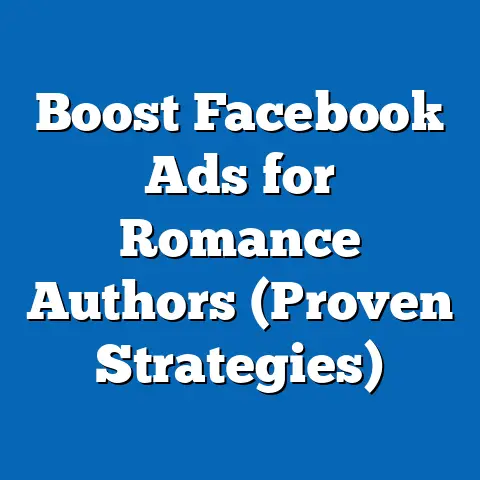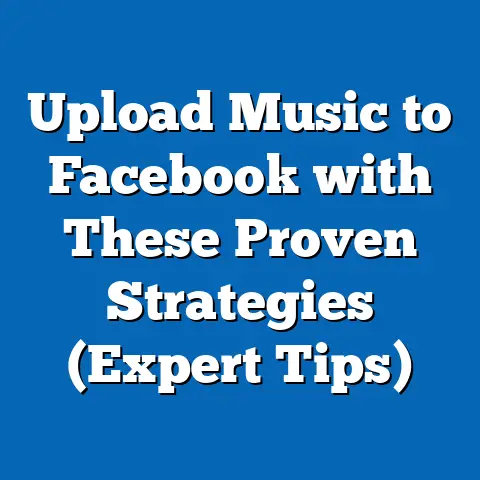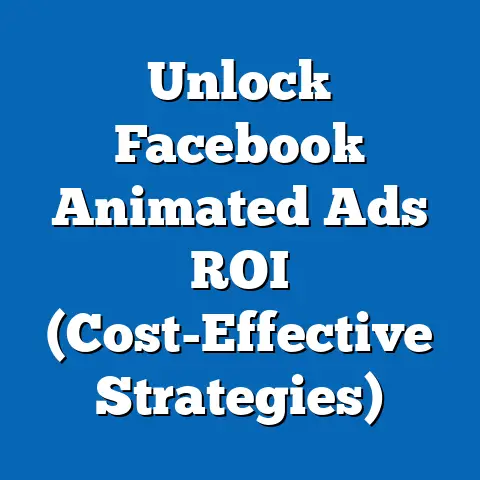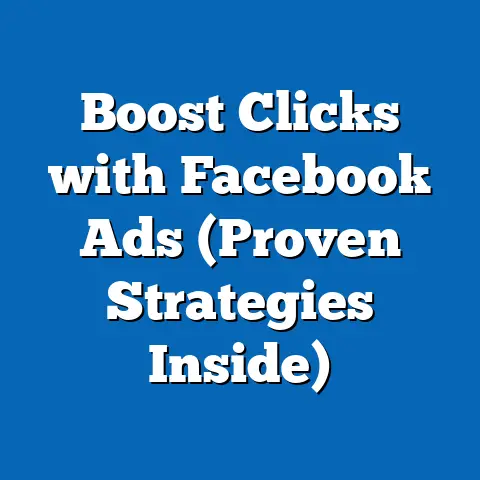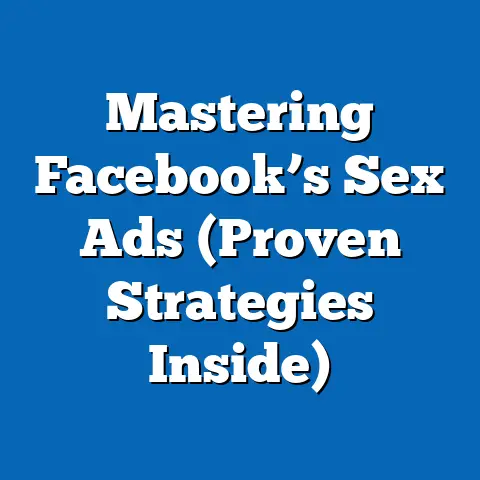Best Days to Post Ads on Facebook (Optimal Engagement Guide)
Have you ever launched a Facebook ad campaign, poured your heart (and budget) into it, only to be met with…crickets? It’s a frustrating experience, and trust me, I’ve been there. We often focus on perfecting our targeting, crafting compelling ad copy, and designing eye-catching visuals, but we sometimes overlook a crucial element: timing. What if I told you that simply posting your ads on different days could drastically impact your engagement rates? Studies have shown engagement rates on Facebook can vary significantly throughout the week, with certain days yielding up to 80% higher engagement than others! This isn’t just about luck; it’s about understanding user behavior and strategically timing your ads for maximum impact.
In this guide, I’ll walk you through the best days to post ads on Facebook, backed by data, expert insights, and my own experiences managing countless campaigns. I’ll break down how user behavior changes throughout the week, how to interpret those changes, and how to use that information to your advantage. Let’s dive in and unlock the secrets to optimal Facebook ad engagement!
Understanding Engagement on Facebook
Before we get into the nitty-gritty of which days are best, let’s level-set on what “engagement” actually means in the context of Facebook ads and why it’s so important.
Defining Engagement
Engagement on Facebook isn’t just about racking up likes. It’s a multifaceted metric that encompasses various user interactions with your ad, including:
- Likes: A simple indication of approval or interest.
- Shares: When users share your ad with their own network, amplifying your reach.
- Comments: A sign of active interest and a potential opportunity for conversation.
- Clicks: Users clicking on your ad to visit your website, landing page, or Facebook page.
- Saves: Users saving your ad to view later, indicating a longer-term interest.
- Video Views: For video ads, the number of times users watch your video.
- Reactions: Using the various Facebook reactions (Love, Haha, Wow, Sad, Angry) to express sentiment.
The Significance of Engagement
Why does engagement matter so much? It’s more than just vanity metrics. High engagement rates translate into several key benefits for your business:
- Increased Reach: When users engage with your ad, it signals to Facebook’s algorithm that your ad is relevant and interesting. This leads to increased organic reach, meaning your ad is shown to more people, even beyond your initial targeting.
- Improved Ad Relevance Score: Facebook assigns a relevance score to your ads, based on how well they resonate with your target audience. Higher engagement leads to a higher relevance score, which can lower your ad costs and improve your ad delivery.
- Higher Conversion Rates: Engaged users are more likely to click through to your website or landing page, and ultimately convert into customers.
- Brand Building: Positive engagement can help build brand awareness, foster a sense of community, and establish your business as a thought leader in your industry.
- Valuable Feedback: Comments and shares provide valuable feedback on your products, services, or messaging, allowing you to refine your strategy and improve your offerings.
The Power of Timing
Now, let’s talk about timing. You might have the most brilliant ad copy and stunning visuals, but if you’re showing it to people when they’re not actively engaging on Facebook, it’s like shouting into a void. The concept is simple: people are more receptive to ads when they’re already in a receptive mindset. Understanding when your target audience is most active and engaged on Facebook allows you to strategically time your ads for maximum impact.
- My Experience: I once ran a campaign for a local restaurant offering lunch specials. Initially, I ran the ads throughout the day, but the results were underwhelming. After analyzing the data, I realized that engagement peaked between 11:00 AM and 1:00 PM, coinciding with lunch breaks. By focusing my ad spend during those peak hours, I saw a significant increase in click-through rates and conversions.
Takeaway: Engagement on Facebook is a multi-faceted metric that drives reach, relevance, conversions, and brand building. Timing your ads strategically is crucial for maximizing engagement and achieving your advertising goals.
Analysis of Facebook User Behavior
To determine the best days to post ads, we need to understand how user behavior fluctuates throughout the week. Facebook usage isn’t consistent; it ebbs and flows with the rhythm of our daily lives.
General User Behavior
Generally, Facebook usage tends to mirror people’s work and leisure patterns:
- Weekdays: Usage is typically higher during lunchtime and evenings, as people take breaks from work or unwind after a long day.
- Weekends: Usage tends to be more consistent throughout the day, as people have more free time.
However, these are just broad generalizations. Let’s delve deeper into how engagement varies by day of the week.
Engagement by Day of the Week
Here’s a breakdown of how user engagement typically shifts throughout the week, based on various studies and observations:
- Monday: Often sees the lowest engagement. People are typically catching up on work after the weekend and may be less receptive to ads.
- Tuesday: Engagement starts to pick up as people settle into their work week.
- Wednesday: Often considered one of the best days for engagement. People are mid-week and may be looking for a mental break.
- Thursday: Still a good day for engagement, with potential for increased shares as people start thinking about the weekend.
- Friday: Results can be mixed. Some studies show decreased engagement as people wind down for the weekend, while others suggest it can still be a decent day, especially in the afternoon.
- Saturday & Sunday: Engagement patterns shift. While overall usage may be high, people are often focused on socializing and relaxing, which can make them less receptive to ads.
Data and Studies
While I can share my personal experiences, it’s important to back up these observations with data. Several studies have explored Facebook user behavior and its impact on ad performance. While specific numbers can vary depending on the source, the general trends remain consistent:
- Sprout Social: In a 2021 study, Sprout Social found that the best times to post on Facebook are Tuesday, Wednesday, and Friday from 9 a.m. to 1 p.m.
- HubSpot: HubSpot’s research suggests that the best days to post on Facebook are Wednesday and Friday.
- BuzzSumo: BuzzSumo’s analysis of millions of Facebook posts found that engagement is generally higher on weekdays than on weekends.
These studies highlight the importance of timing in your ad posting strategy. By understanding when your target audience is most active, you can significantly increase your chances of capturing their attention.
Takeaway: Facebook user behavior fluctuates throughout the week, with weekdays generally seeing higher engagement than weekends. Understanding these patterns is crucial for timing your ads effectively.
Best Days to Post Ads
Now, let’s get down to brass tacks. Based on the analysis above, which days are the best to post ads on Facebook? Keep in mind that these are general guidelines, and the optimal days for your specific business may vary depending on your target audience and industry. But, here’s a starting point.
Monday: Tread Carefully
Monday often sees the lowest engagement rates on Facebook. People are typically transitioning from the weekend, catching up on work, and may be less receptive to ads.
- Why? Monday is often associated with stress and a focus on productivity. People are less likely to be browsing social media for leisure.
- When to Post: If you must post on Monday, try targeting the late afternoon or early evening, when people are winding down for the day.
- What to Post: Focus on content that is informative, helpful, or inspiring, rather than overtly promotional.
Tuesday: A Rising Tide
Tuesday often marks a rise in user engagement as people settle into their work week.
- Why? The initial Monday rush has subsided, and people may be more open to distractions and entertainment.
- When to Post: Mid-morning or early afternoon can be a good time to capture attention.
- What to Post: Experiment with a variety of content, including promotional ads, engaging questions, and informative articles.
Wednesday: Peak Performance
Wednesday is often considered one of the best days to post ads on Facebook.
- Why? People are mid-week and may be looking for a mental break from work.
- When to Post: Mid-morning to early afternoon is often the sweet spot.
- What to Post: High-quality, engaging content that captures attention and encourages interaction. Consider running contests, polls, or interactive quizzes.
Thursday: Share-Worthy Content
Thursday can be another strong day for engagement, with potential for increased shares as people start thinking about the weekend.
- Why? People are anticipating the weekend and may be more likely to share content with their friends.
- When to Post: Mid-morning to early afternoon is still a good bet.
- What to Post: Focus on content that is shareable, entertaining, or thought-provoking. Consider running promotions or highlighting user-generated content.
Friday: Mixed Results
Friday’s results can be mixed, depending on your target audience and industry. Some studies show decreased engagement as people wind down for the weekend, while others suggest it can still be a decent day, especially in the afternoon.
- Why? People may be focused on wrapping up work or making plans for the weekend.
- When to Post: Afternoon or early evening may be the best time to capture attention.
- What to Post: Focus on content that is lighthearted, fun, or related to weekend activities. Consider running promotions or highlighting user-generated content.
Saturday & Sunday: The Weekend Shift
Weekends often see lower engagement rates for ads, as people are focused on socializing, relaxing, and spending time offline.
- Why? People are less likely to be browsing Facebook for information or entertainment.
- When to Post: If you must post on weekends, try targeting the late afternoon or early evening, when people may be winding down for the day.
- What to Post: Focus on content that is highly relevant to weekend activities, such as local events, dining options, or outdoor adventures.
Takeaway: Wednesday and Thursday often emerge as the best days for posting ads on Facebook, while Mondays and weekends tend to see lower engagement. Tailor your content and timing to match the specific mood and mindset of each day.
Time of Day Considerations
While the day of the week is important, it’s only one piece of the puzzle. The time of day also plays a crucial role in determining your ad’s success.
Peak Hours for Engagement
Just like different days have different engagement levels, different times of day also see varying levels of activity on Facebook. Here are some general guidelines:
- Morning (6:00 AM – 9:00 AM): People may be checking Facebook while getting ready for work or school.
- Lunchtime (11:00 AM – 1:00 PM): A popular time for people to take a break and browse social media.
- Afternoon (1:00 PM – 4:00 PM): Engagement may dip slightly as people return to work.
- Evening (4:00 PM – 7:00 PM): Another peak time as people unwind after work or school.
- Late Night (7:00 PM – 10:00 PM): Engagement may remain high, especially for entertainment-related content.
Combining Day and Time
The real magic happens when you combine your knowledge of the best days with the best times. For example, if you’re targeting working professionals, posting an ad on Wednesday at lunchtime could be a highly effective strategy.
- My Experience: I ran a campaign for a fitness studio offering evening classes. I initially ran the ads throughout the day, but the results were mediocre. After analyzing the data, I realized that engagement peaked between 5:00 PM and 7:00 PM, when people were leaving work and considering their evening activities. By focusing my ad spend during those peak hours on Wednesday and Thursday, I saw a significant increase in sign-ups.
Tips for Timing Your Ads
Here are some practical tips for timing your ads based on user habits:
- Lunchtime Engagement: Target your ads to coincide with lunch breaks, especially on weekdays.
- Evening Scrolls: Capitalize on evening engagement by running ads that are relevant to relaxation, entertainment, or social activities.
- Weekend Activities: Target your ads to coincide with weekend activities, such as local events, dining options, or outdoor adventures.
- Consider Time Zones: If you’re targeting a national or international audience, be mindful of time zones and adjust your ad schedules accordingly.
Takeaway: Combining your knowledge of the best days with the best times can significantly boost your ad engagement. Experiment with different timing combinations to find what works best for your target audience.
Industry-Specific Insights
While the general guidelines above provide a solid foundation, it’s important to remember that different industries may have varying optimal posting days and times. Your target audience’s habits and preferences can significantly impact the effectiveness of your ads.
E-commerce
For e-commerce businesses, weekdays tend to be more effective than weekends, as people are often browsing online stores during their lunch breaks or after work.
- Best Days: Tuesday, Wednesday, Thursday
- Best Times: Lunchtime (11:00 AM – 1:00 PM), Evening (4:00 PM – 7:00 PM)
- Content Focus: Product promotions, special offers, new arrivals
B2B
For B2B businesses, weekdays are crucial, as professionals are more likely to be focused on work-related content during the week.
- Best Days: Tuesday, Wednesday, Thursday
- Best Times: Morning (9:00 AM – 11:00 AM), Afternoon (1:00 PM – 3:00 PM)
- Content Focus: Informative articles, industry insights, case studies
Entertainment
For entertainment businesses, weekends can be effective, as people are often looking for ways to relax and unwind.
- Best Days: Friday, Saturday, Sunday
- Best Times: Afternoon (2:00 PM – 5:00 PM), Evening (7:00 PM – 9:00 PM)
- Content Focus: Event announcements, movie trailers, music releases
Understanding Your Target Audience
The key to tailoring your ad posting strategy is to understand your target audience. Consider factors such as:
- Demographics: Age, gender, location, education, income
- Interests: Hobbies, passions, online behavior
- Industry: Profession, job title, company size
- Pain Points: Challenges, frustrations, needs
By creating detailed buyer personas, you can gain valuable insights into your target audience’s habits and preferences, allowing you to optimize your ad posting schedule for maximum impact.
Takeaway: Different industries may have varying optimal posting days and times. Understanding your target audience’s habits and preferences is crucial for tailoring your ad posting strategy effectively.
Tools and Resources for Tracking Engagement
Now that you understand the importance of timing, how do you actually track your engagement rates and determine the best days and times for your specific business? Fortunately, Facebook provides a wealth of data and analytics tools to help you monitor your ad performance.
Facebook Insights
Facebook Insights is a powerful tool that provides detailed information about your audience, your content, and your ad performance. You can access Facebook Insights by going to your Facebook page and clicking on the “Insights” tab.
-
Key Metrics:
- Reach: The number of people who saw your ad.
- Engagement: The number of likes, shares, comments, and clicks on your ad.
- Click-Through Rate (CTR): The percentage of people who clicked on your ad after seeing it.
- Cost Per Click (CPC): The average cost you paid for each click on your ad.
- Conversion Rate: The percentage of people who completed a desired action (e.g., purchase, sign-up) after clicking on your ad.
-
Analyzing Data: Use Facebook Insights to track your engagement rates over time and identify patterns. Pay attention to which days and times are seeing the highest engagement.
Key Metrics:
- Reach: The number of people who saw your ad.
- Engagement: The number of likes, shares, comments, and clicks on your ad.
- Click-Through Rate (CTR): The percentage of people who clicked on your ad after seeing it.
- Cost Per Click (CPC): The average cost you paid for each click on your ad.
- Conversion Rate: The percentage of people who completed a desired action (e.g., purchase, sign-up) after clicking on your ad.
Analyzing Data: Use Facebook Insights to track your engagement rates over time and identify patterns. Pay attention to which days and times are seeing the highest engagement.
A/B Testing
A/B testing, also known as split testing, is a powerful technique for comparing different versions of your ads to see which one performs best. You can use A/B testing to test different posting times and days to find the optimal schedule for your specific audience.
- How to A/B Test:
- Create two versions of your ad, with one variable changed (e.g., posting time).
- Run both ads simultaneously to the same target audience.
- Track the performance of each ad and identify the winner.
- Repeat the process with other variables to continuously optimize your ad performance.
- Create two versions of your ad, with one variable changed (e.g., posting time).
- Run both ads simultaneously to the same target audience.
- Track the performance of each ad and identify the winner.
- Repeat the process with other variables to continuously optimize your ad performance.
My Experience: I once ran an A/B test for a client’s Facebook ad campaign. We tested posting the same ad at different times of the day and on different days of the week. The results were eye-opening! We discovered that posting the ad on Wednesday evenings generated significantly more engagement and conversions than posting it on Monday mornings. This simple test helped us optimize the campaign and achieve a much higher ROI.
Third-Party Analytics Tools
In addition to Facebook Insights, several third-party analytics tools can provide more in-depth data and insights into your ad performance. Some popular options include:
- Google Analytics: Track website traffic and conversions from your Facebook ads.
- HubSpot: Monitor your overall marketing performance, including Facebook ads.
- Sprout Social: Manage your social media presence and track engagement rates.
Takeaway: Use Facebook Insights, A/B testing, and third-party analytics tools to track your engagement rates, identify patterns, and continuously optimize your ad posting schedule.
Conclusion
Timing is everything, especially when it comes to Facebook advertising. By understanding how user behavior fluctuates throughout the week and strategically timing your ads for maximum impact, you can significantly boost your engagement rates, lower your ad costs, and achieve your advertising goals.
Key Takeaways
Let’s recap the key points we’ve discussed in this guide:
- Engagement on Facebook is a multi-faceted metric that drives reach, relevance, conversions, and brand building.
- Facebook user behavior fluctuates throughout the week, with weekdays generally seeing higher engagement than weekends.
- Wednesday and Thursday often emerge as the best days for posting ads on Facebook, while Mondays and weekends tend to see lower engagement.
- Combining your knowledge of the best days with the best times can significantly boost your ad engagement.
- Different industries may have varying optimal posting days and times.
- Understanding your target audience’s habits and preferences is crucial for tailoring your ad posting strategy effectively.
- Use Facebook Insights, A/B testing, and third-party analytics tools to track your engagement rates, identify patterns, and continuously optimize your ad posting schedule.
Final Thoughts
Facebook advertising is a dynamic and ever-evolving landscape. What works today may not work tomorrow. That’s why it’s crucial to stay informed, experiment with different strategies, and continuously analyze your results. Remember, the key to success is to understand your audience, test your assumptions, and adapt your approach based on the data.
Call to Action
Now it’s your turn! I encourage you to experiment with your posting schedules based on the insights and data shared in this guide. Track your results, analyze your data, and continuously optimize your approach. I’d love to hear about your experiences! Share your comments below and let me know what days and times have worked best for you. Together, we can unlock the secrets to optimal Facebook ad engagement and achieve our advertising goals.

